-
How to Say No: 30 Surprising Ways to Reject Customers
Mon, 28 Jan 2019, in Customer Service
Enjoying this one? You might also like 30 Do’s and Don’ts for Better Customer Service
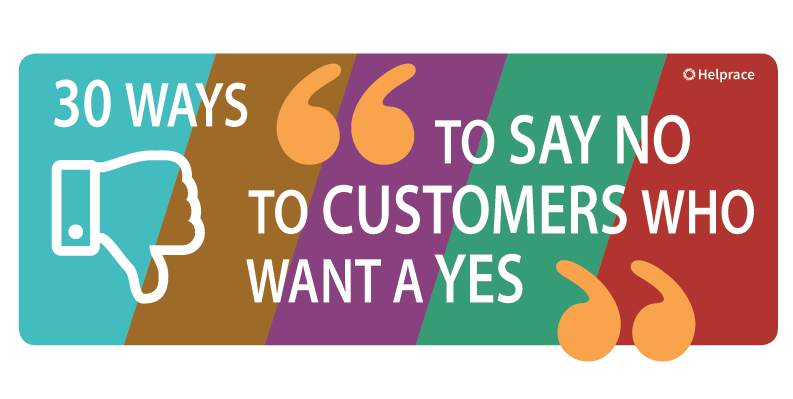
No one likes rejection – certainly not your customers. Hence the question: is there a way of saying “no” to customers that expect nothing less than a “yes”?
Unfortunately, most support representatives are worried that by saying no, they are somehow jeopardizing a relationship they’ve built with their customers. A “no” is the ultimate relationship tester and we, as human beings, react to rejection quite unpredictably.
Read More: Top 10 Things not to Say to Angry Customers
When customers are upset about something, pushing their concerns aside is the last thing you want to do. You’re pushing away any chance of a discussion you’d otherwise not have: a clarification on their problem or what they’re trying to accomplish. Lend an ear, perform the role of an investigator, and offer a helping hand (if you can).
Still, there are times when a no-nonsense rejection might be exactly what the doctor ordered.
Read More: How Speed Kills in Customer Service
Just like any skill, saying the right thing comes with lots of practice. By learning to say no the right way, you’ll master turning negative situations into positive ones. You get to clear up misunderstandings and collect valuable feedback. Here are 30 ways you can say no and still end up on your customers’ good side:
The no
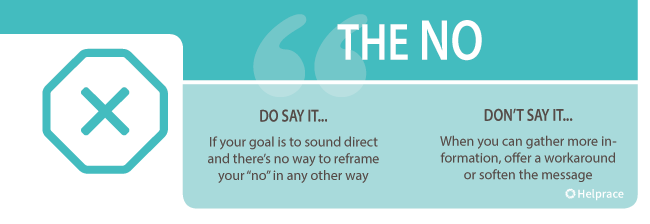
1. Simply say it: no.
Just saying the word may be the best course of action. It may be better to say “no” and disappoint someone, than “maybe, let me check with marketing” and leave the customer hanging indefinitely.
2. Unfortunately, no, because…
Try adding a reason, however trivial. This will help soften your rejection. “We’re currently prioritizing feature x, y and z. Would you like to learn more?” Avoid rambling on or sounding too apologetic.
3. No. Here’s what we can do…
Go out of your way to accommodate someone, especially if they are a new, or even if they’re an ordinary customer with an extraordinary problem. You may need to negotiate or meet them halfway.
4. No. We can offer you…
Can you offer a freebie or a discount to compensate? Avoid offering too much compensation for their troubles – this can set unreasonable expectations and embolden customers to demand more.
5. Say it twice, if you have to
Some people are not used to being rejected. Others people are unaware of boundaries, or can be used to others caving in once they ask and ask. Don’t be afraid to repeat yourself if you have to.
Sometimes, all you gotta do is drop the “no bomb”. Bottom line is, sometimes your customer just doesn’t understand what it is that you’re doing, what you can or cannot do. It’s your job to coach, direct and assist – and that means saying the right thing (even if it’s something negative).The no & but
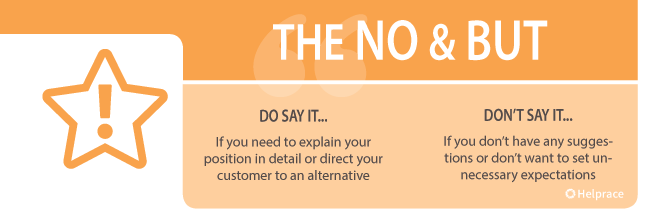
6. No, but here’s a workaround…
Think of a solution that might help the customer. If you can’t offer a refund on a customer’s prepaid plan, can you offer a credit instead? Can you put an account on hold and turn it on later?
7. No, but you can leave your feedback about it…
Even if you can’t give customers what they want, reassure them that their voice matters. If it sounds like a good idea, document and evaluate their feedback. PS: issue tracking software allows you to do just that.
8. No, but have you tried this alternative?
Sometimes you may need to suggest a product, service or an unrelated item that’s (probably) exactly what your customer needs. Instead of just a no, you’ll be helpful and they’ll appreciate it.
9. No, but (there is still hope!)
Is it a bad time? Are you certain that someone else can help the customer? You might just have to pass the buck to John in accounting, or say “not now, but we can try a different time”.
10. Don’t get carried away
We preach the importance of taking every opportunity to communicate with your customers. However, don’t get too carried away or stray off topic (some of us are quite guilty of that!)
Remember Costanza from Seinfeld and all his rambling to prove a point? In an effort to turn a “no” into a “yes”, we tend to invent elaborate ruses and excuses. Being a habitual people-pleaser can suck up much of your time (wile your customers could even call you out on it).The no & why
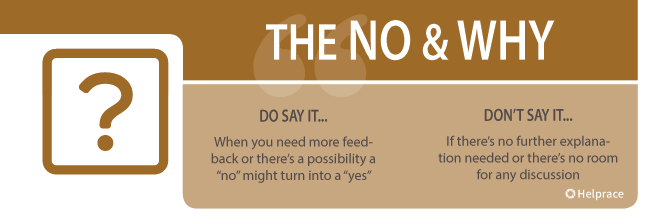
11. The reason we can’t do this is…
Sometimes the customer needs some guidance or a push in the right direction. You can’t help them, so explain why – educate, inform, and get them to understand things from your perspective.
12. No, we don’t normally do this…
Are they asking for a discount? Ask “Why? Can I hear more about your case?” For example, a non-profit or learning institution may offer your brand more exposure, bringing you future clients.
13. No, we can’t. Why do you need this feature?
Every customer has their own unique story to tell. When they have a problem that needs solving, it pays to listen. After all, you may uncover opportunities to improve.
14. No, why would you want to do that?
The customer may have a convoluted way of doing something when a much easier options is available. Again, use the opportunity to learn more, collect feedback and improve.
15. If possible, leave out the no
If you want to avoid saying no altogether, the next best thing might be to ask why. Not only it allows you to reframe your answer in a positive way, you’ll also end up getting valuable feedback!
At first glance, questions like “Can you fix it?” or “Can you refund me?” may have a clear “no ”, but dismissing the “why” closes the door to discussion. And closing the door to what your customers want gives them a reason to look elsewhere.The thanks & no
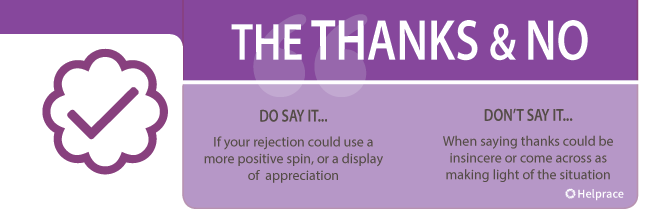
16. Thanks for the feedback, but I can’t.
Your customer made a conscious effort to give you feedback, share their problem areas, or simply took the time to reach out to you. Let them know you appreciate the gesture.
17. I appreciate you asking, but this won’t work.
Say that their question matters and you’ll make a note of it. Find a way to document similar questions and group them together. Use this to prioritize a fix by the product team.
18. Thanks for sharing this. I can see why…
If a customer is asking a long question, spend extra time on your answer, too. To supplement your answer, point them to your self-service documentation or knowledge base.
19. I know this isn’t what you were looking for…
Put yourself in your customer’s shoes. They may have a specific solution in mind, including your role in it. Thank them for the suggestion and guide the them through the solution.
20. Don’t go crazy with thanks
Customers are particularly good at spotting insincerity or sarcasm. They also (typically) want to see less talk, more action. Don’t go overboard, especially if it’s a big problem or an important client.
Should you start with a positive (thanks) and follow up with a negative (rejection)? It’s an old cliche, but turns out it does make a difference. According to psychology researchers, people who feel good at the beginning of an interaction, but get bad news afterwards are more likely to act to reverse the situation.The I should not
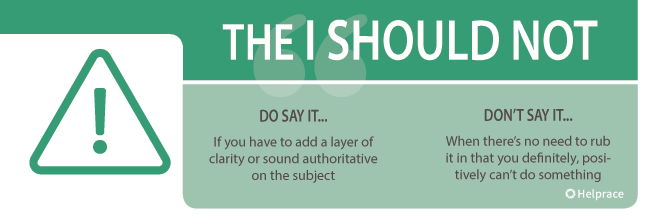
21. It’s not the best solution.
Support reps should be authoritative and accountable – that means knowing what’s possible and what isn’t. Ensure the customer doesn’t come back and say “but I thought you meant I could do it.”
22. It wouldn’t be appropriate…
Feel like your customer is taking advantage of you or making an uncomfortable request? Avoid freebies, accepting generous offers or being coerced to engage with a customer in an unconformable manner.
23. I can’t tell you right now…
If you can’t give an answer because you don’t know, say it. But don’t leave them hanging – discuss it with your superiors and get back to the customer as soon as possible.
24. What are your priorities?
If a customer comes to you with a number of requests (that will likely result in rejection), ask them to weigh their priorities. Find out what’s more important and if the other questions can wait.
25. Keep company policy out
It’s always frustrating to hear “sorry it’s against company policy” when you’re on the receiving end. Make away with rigid rules or cultures that prevent employees from making the call (no matter how small).
Have a way to escalate the really difficult requests to decision-makers in your organization. Allow workers within departments to move horizontally (as well as up), to share ideas to reach a common goal. Make every request count: Is it a deal breaker? Is this part of some nice-to-haves?The I wish I could
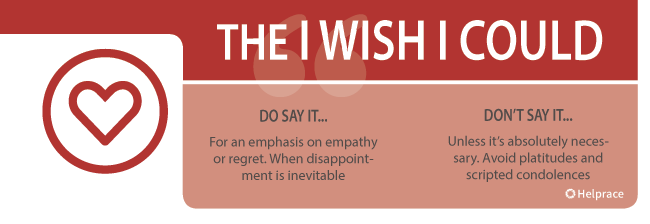
26. I feel the same way.
Empathize. Let your customer know that you truly care about the predicament they’re in. Even if the problem is completely out of your scope, express your regret for not being able to help them.
27. I can’t make any promises, but…
Be clear about what you can and can’t do. If you’re going to share their feedback up the totem pole, be accountable for it. And don’t forget to follow back with the customer.
28. I wish there’s something I could do, but…
If the issue truly falls outside your ability (or authority) to address it, why not be honest about it. Apologize and refer the customer to the right resource, department or individual.
29. Normally I’d say yes, but…
This is one of the more difficult situations. Just because a customer is used to hearing a yes (or you agreed to their requests before) doesn’t mean you’re stuck being a “yes guy” forever.
30. Use a white lie
Normally we’re all about telling the truth. In some cases, to really avoid hurting someone’s feelings (or save an important customer), you must get creative with your rejection. Remember: use with caution!
Can you treat the 100th “no” like the first? After all, saying no is the toughest part of any job. Letting down customers repeatedly throughout the day can wear anyone out, especially if it concerns one issue that’s affecting many customers.When a no won’t cut it…
There are times when a no (or a yes for that matter) is going to result in an unhappy customer no matter what. Still, there are some customers that can’t accept anything except their own version of events, and knowing what to do in those situations is another article for another time.
Of course, you could always cut ties with a problem customer. Should you do it? Is there any reason to? We explore this in our next post.
Tags: customer service






